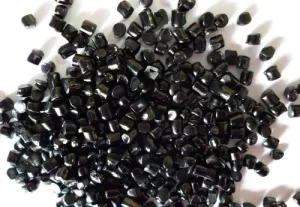Compound hdpe for large tanks and reservoirs
When Compound hdpe for large tanks and reservoirs using rotational molding, the formulation must ensure durability, environmental resistance, and mechanical integrity. Such applications require specialized considerations to meet the high demands of water or chemical storage.
Key Requirements for Large Tanks and Reservoirs
- High Impact Strength:
Tanks must withstand impacts during transport and installation without cracking.
- Environmental Resistance:
Prolonged exposure to UV radiation and extreme weather conditions demands UV stabilization.
- Chemical Resistance:
Many tanks are used for storing chemicals or potable water, requiring resistance to acids, alkalis, and other substances.
- Structural Integrity:
Large tanks must maintain uniform wall thickness with high tensile strength and stiffness to avoid deformation or rupture under pressure.
- Food-Grade Certification (Optional):
Tanks storing potable water need to comply with FDA or similar standards, requiring non-toxic and food-safe additives.

HDPE Compounding for Large Tanks
Base Resin Selection
- Density: Use HDPE with a density range of 0.940–0.955 g/cm³ for an optimal balance between stiffness and impact resistance.
- Melt Flow Index (MFI): Choose a resin with MFI of 3–5 g/10 min at 190°C/2.16 kg. Lower MFI values ensure better mechanical properties in thick walls.
Additives for Performance
Additives enhance the resin’s properties to meet the specific requirements of large tanks and reservoirs.
| Additive |
Typical Amount (%) |
Purpose |
| UV Stabilizers |
0.2–1% |
Protect against sunlight-induced degradation. HALS (Hindered Amine Light Stabilizers) are commonly used. |
| Antioxidants |
0.1–0.5% |
Ensure thermal stability during processing and prevent oxidation. |
| Impact Modifiers |
1–2% |
Enhance toughness and resistance to cracking. |
| Colorants |
1–2% |
Provide aesthetic color while being UV-stable. |
| Processing Aids |
0.1–0.3% |
Improve flowability and reduce defects like pinholes. |
| Food-Grade Additives (Optional) |
0.1–1% |
Ensure compliance for potable water storage. |
| Filler (Optional) |
0–5% |
Add stiffness or reduce cost (e.g., talc or calcium carbonate). |
Compounding Process
- Blending: The HDPE resin is dry blended with the additives to create a uniform mixture.
- Melt Compounding: The blend is extruded using a twin-screw extruder at controlled temperatures (180–220°C) to disperse additives homogeneously.
- Pulverizing: The extruded compound is cooled and ground into fine powder (300–500 microns) using cryogenic grinding to minimize thermal degradation.
- Testing: Conduct quality control tests (described below) before shipping the compound for molding.
Key Properties for Large Tanks
After compounding, the HDPE must exhibit the following properties:
- Density: 0.940–0.955 g/cm³
Ensures sufficient stiffness for large structures.
- Impact Resistance:
The material should resist cracking at low temperatures, tested with drop impact methods.
- Environmental Stress Crack Resistance (ESCR):
Critical for tanks exposed to external stresses and chemical agents.
- UV Resistance:
Measured in terms of hours of exposure in a xenon arc or UV chamber.
- Tensile Strength:
Ensures the tank can handle internal pressure without deformation.
Typical Compound Formulation for Large Tanks
| Component |
Weight (%) |
Purpose |
| HDPE Resin |
96–97% |
Base polymer for strength and durability. |
| UV Stabilizers (HALS) |
0.5–1% |
Protects against UV degradation. |
| Antioxidants |
0.2–0.5% |
Improves thermal stability during processing. |
| Colorants |
1–2% |
Adds color and additional UV resistance. |
| Impact Modifiers |
1–2% |
Increases toughness. |
| Filler (Optional) |
2–5% |
Adds stiffness or reduces cost. |
Processing Recommendations
- Molding Temperature: Typically ranges from 200–250°C, depending on the resin grade.
- Heating Time: Prolonged to ensure full melting and sintering of the material in thick-walled parts.
- Cooling Cycle: Gradual cooling to minimize internal stresses and warping in large tanks.
- Mold Rotation Speed: Optimize for uniform wall thickness, balancing speed and resin flow.
Quality Control Tests
- Melt Flow Index (MFI):
Verifies that the resin flows properly for rotational molding.
- Tensile Strength and Elongation at Break:
Ensures structural integrity and flexibility.
- Environmental Stress Crack Resistance (ESCR):
Measures the tank’s ability to resist cracking under stress and chemical exposure.
- UV Resistance Testing:
Simulates outdoor conditions to ensure long-term stability.
-

Drop Impact Test:
Evaluates the ability of the tank to resist damage when dropped.
- Wall Thickness Uniformity:
Ensures consistent molding for durability and functionality.
Benefits of HDPE in Large Tank Applications
- High Chemical Resistance: Ideal for water, oil, and chemical storage.
- Lightweight Yet Strong: HDPE tanks are easy to transport and install without sacrificing durability.
- Cost-Effective: HDPE is more economical than many alternative materials like metals or composites.
- UV Stability: Properly hdpe granule for rotational molding provides long-term resistance to sunlight, making it ideal for outdoor tanks.

